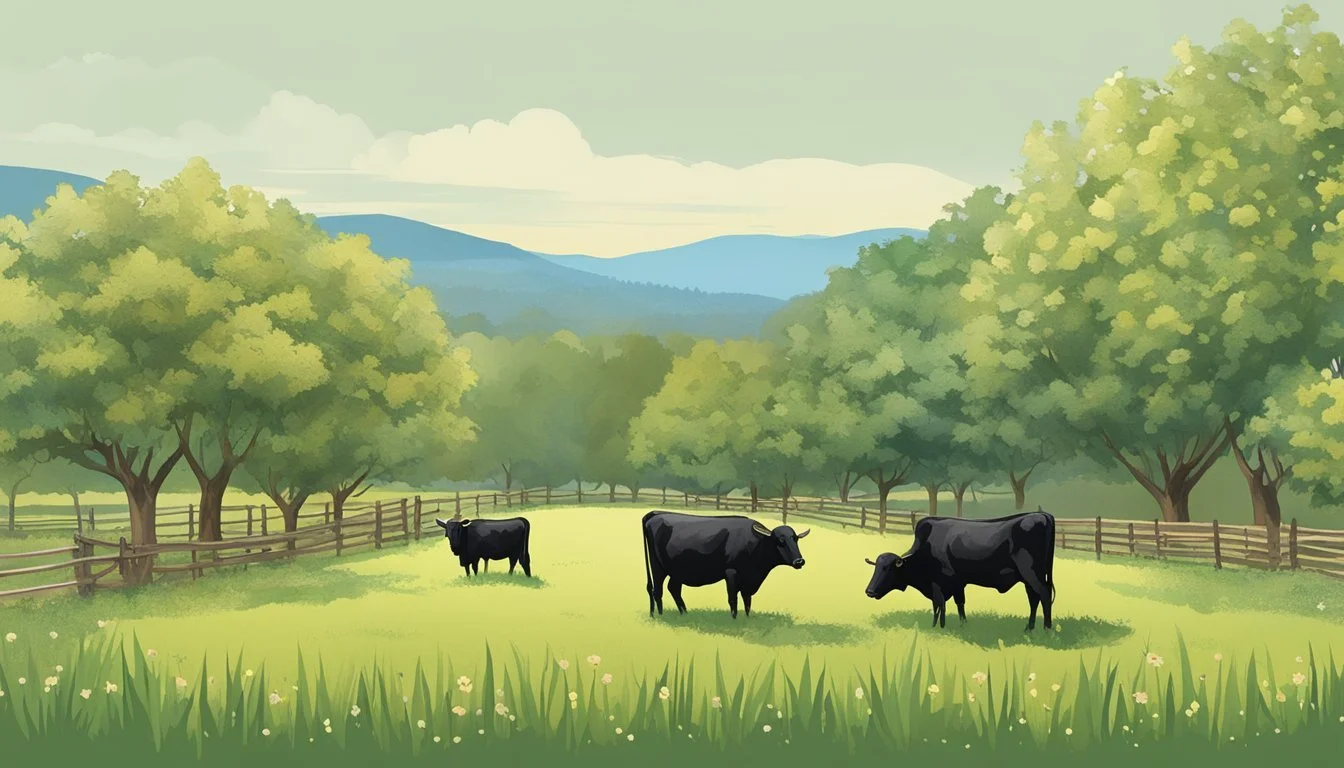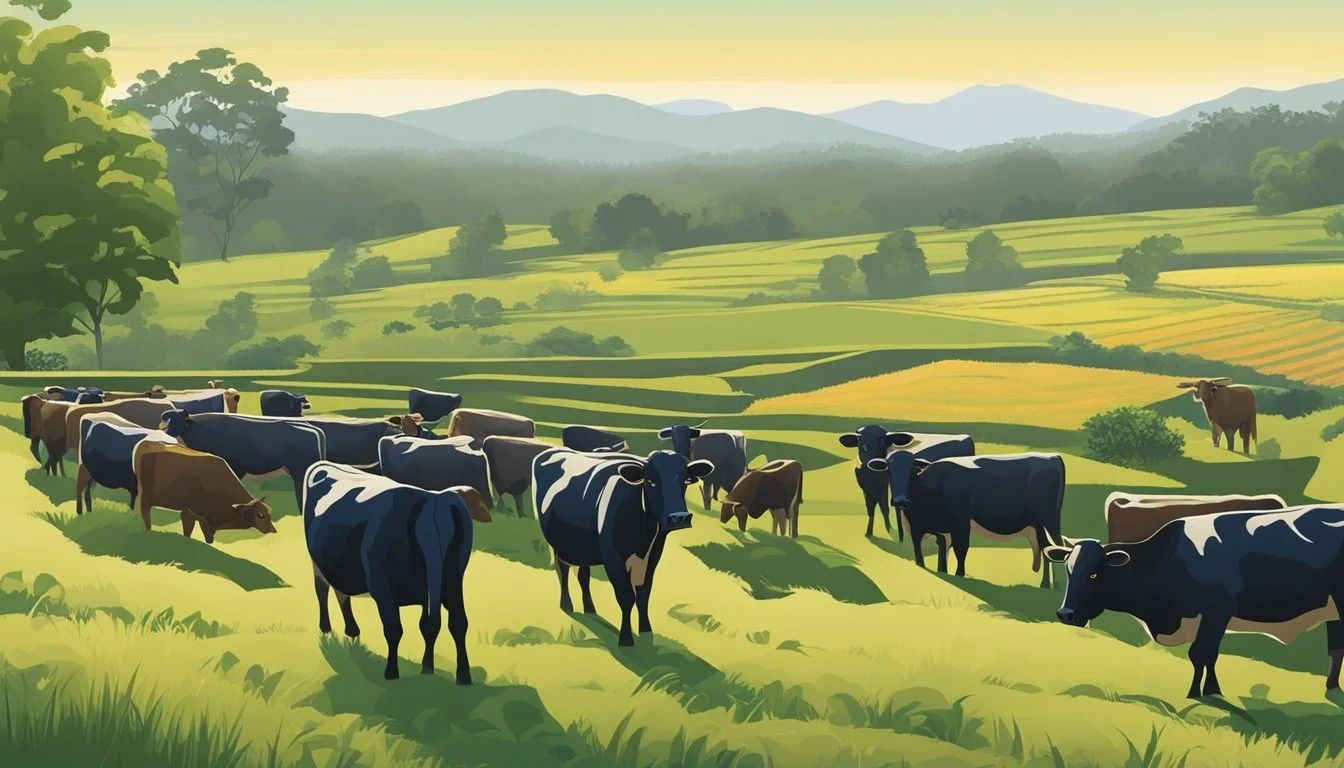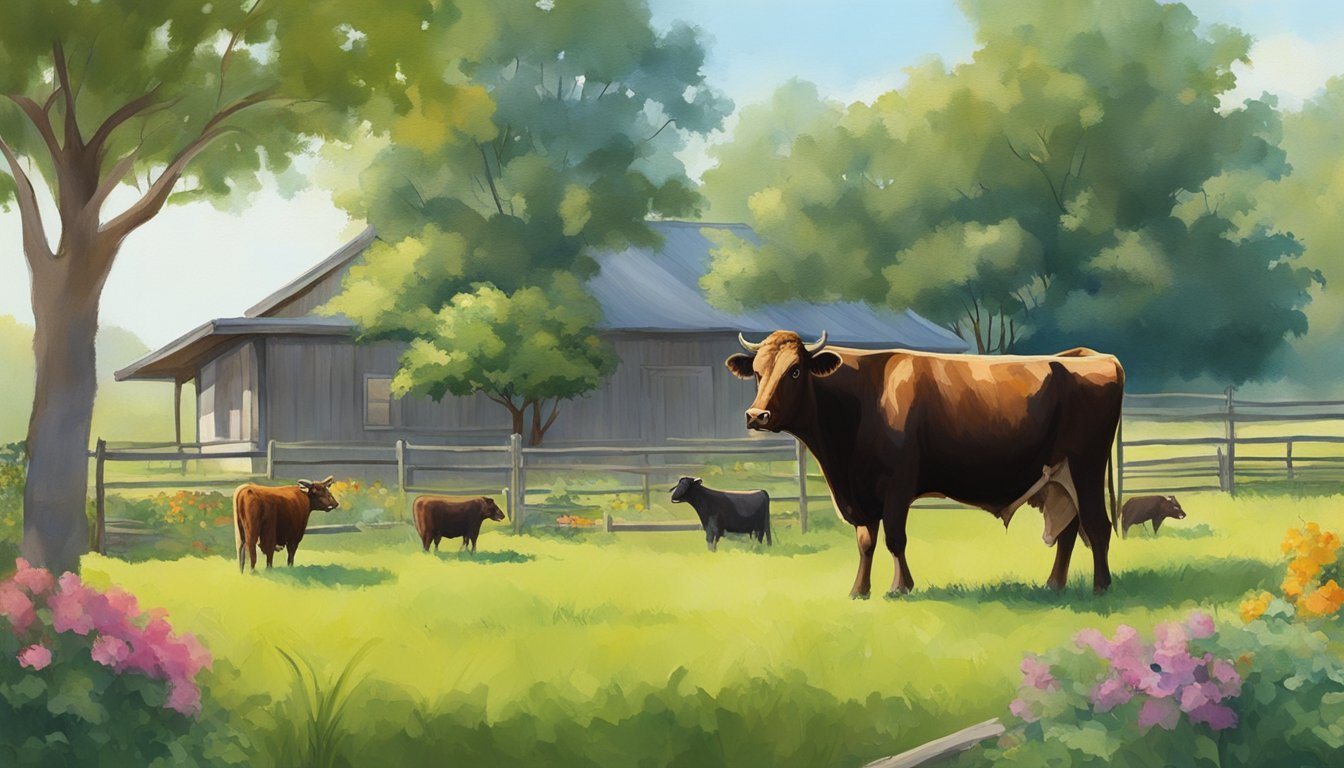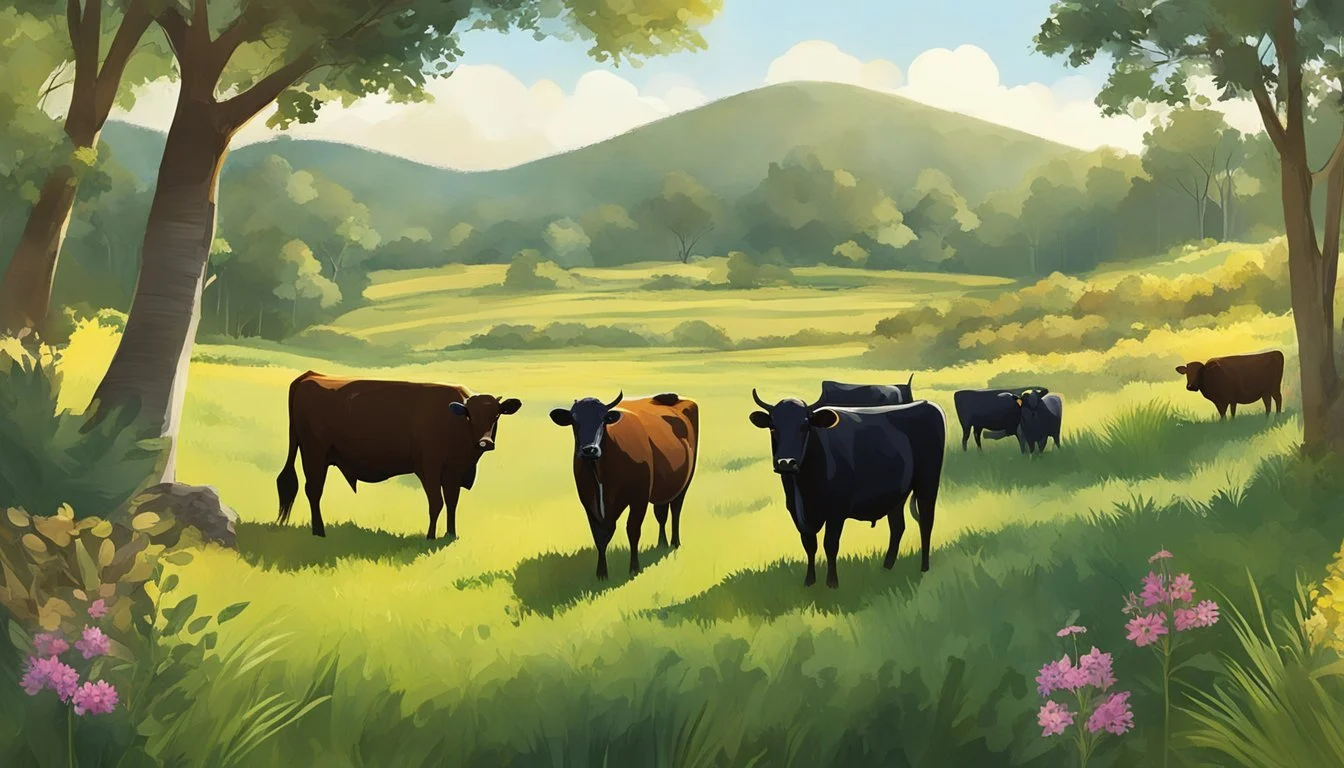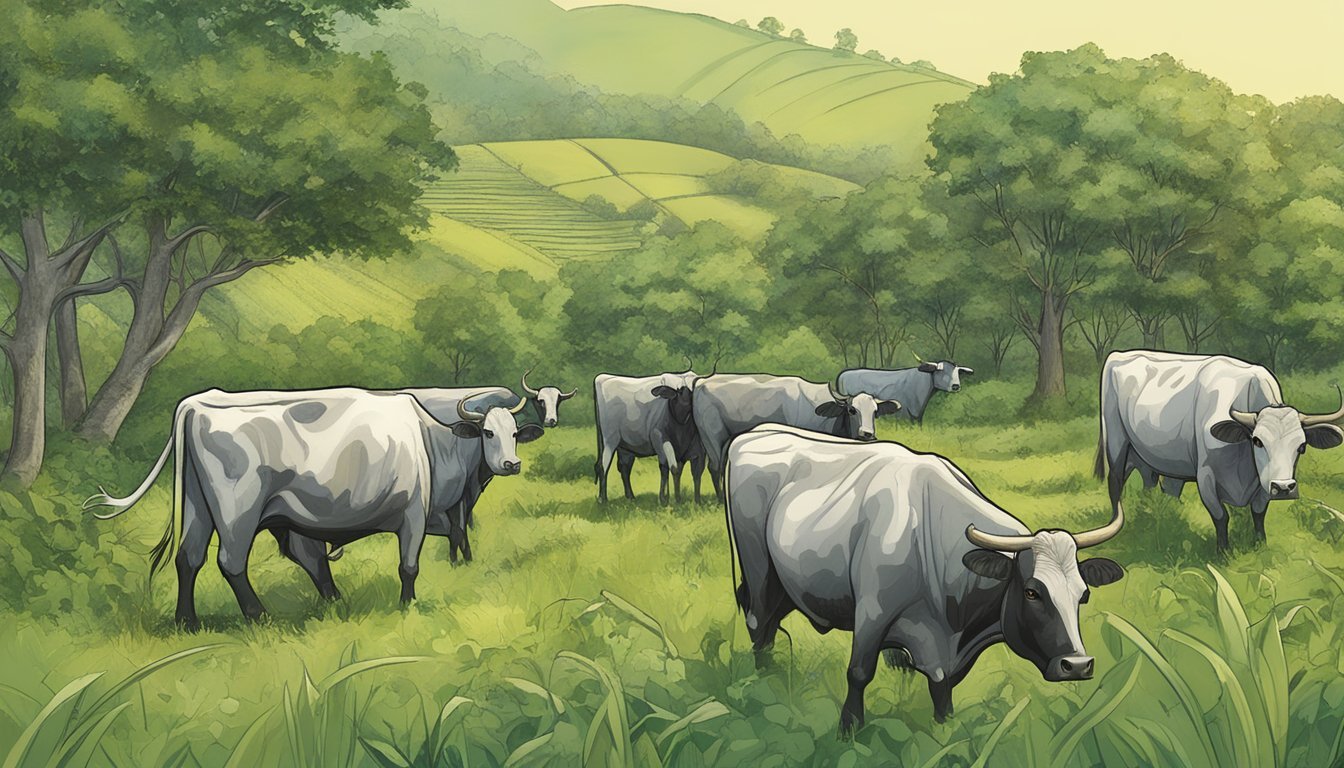The Role of Dexter Cattle in Permaculture
Enhancing Sustainable Agricultural Practices
Dexter cattle, a versatile and compact breed, have shown considerable promise in advancing the principles of permaculture and sustainable agriculture. Originating from Ireland, these small-sized cattle have gained popularity among smallholders in the United States, New Zealand, and beyond due to their dual-purpose nature, providing both quality milk and meat. In permaculture systems, which strive to create sustainable and self-sufficient agricultural landscapes, Dexter cattle fulfill multiple roles effectively. They help in managing pasture health through holistic grazing, which in turn supports the development of complex ecosystems within the farmland.
Incorporation of livestock into permaculture is a strategic move towards achieving agricultural sustainability, and Dexter cattle stand out as an ideal choice for this integration. Their adaptability allows them to thrive in a variety of climatic conditions, making them suitable for various American and New Zealand landscapes. The modest requirements of Dexter cattle in terms of space and resources align with the sustainable agriculture goal to reduce the ecological footprint of farming practices. They contribute to the closed-loop systems of permaculture by providing organic fertilizer through manure, essential for soil fertility without reliance on synthetic inputs.
The role of Dexter cattle extends to the very ethos of sustainable agriculture, which seeks not only to preserve the environment but also to ensure economic viability and social equity. Small-scale farmers appreciate the breed's easy manageability and lower maintenance costs, which promote economic sustainability. In fostering biodiversity and enhancing resource cycles, Dexters serve as integral components in the design and functionality of permaculture systems aiming for long-term resilience and environmental balance.
Permaculture Fundamentals
Permaculture is a design system rooted in the replication of patterns found in natural ecosystems. Its core lies in a set of design principles and practices that emphasize sustainable and regenerative agriculture.
Principles and Practices
Permaculture operates on several key principles, which include observing and interacting with nature, capturing and storing energy, obtaining a yield, and applying self-regulation and feedback. Practices involve the strategic placement of elements in the landscape to maximize their usefulness and productivity. For instance, in permaculture design, elements like water sources, plant beds, and livestock are arranged to create synergies and minimize waste.
Observe and Interact: Understanding the natural processes and adapting interventions accordingly.
Capture and Store Energy: Making the most of natural resources, like sunlight and water.
Obtain a Yield: Ensuring that the permaculture system produces tangible results in terms of food production or other beneficial outputs.
Apply Self-Regulation: Monitoring and adjusting practices to ensure the system's sustainability and resilience.
Bill Mollison's Legacy
Bill Mollison, co-founder of the permaculture movement, is recognized for articulating the foundational concepts of this design philosophy. He developed the idea of a self-sufficient, sustainable agricultural system that could function indefinitely. Mollison's legacy includes a worldwide community of practitioners and the Permaculture Design Course, which educates individuals on implementing permaculture principles.
Key Contributions:
Establishing permaculture's philosophical framework.
Creating educational pathways for permaculture knowledge dissemination.
David Holmgren's Contribution
David Holmgren, as a co-originator, further refined the permaculture concept by focusing on practical applications in different landscapes and scenarios. Holmgren's principles, such as "Use and value renewable resources and services" or "Design from patterns to details," have been instrumental in the proliferation of permaculture methods.
Notable Principles:
Valuing and utilizing renewable resources.
Designing by recognizing patterns in nature.
Permaculture Research Institute
The Permaculture Research Institute (PRI), established in 1978, serves as a hub for research, education, and demonstration of permaculture techniques. It continues Mollison's and Holmgren's work through global outreach and the promotion of practical permaculture solutions. The institute's efforts in knowledge transfer and support for practitioners are vital in the expansion of sustainable agricultural practices.
PRI's Role:
Facilitating ongoing permaculture education and research initiatives.
Demonstrating the efficacy of permaculture principles in various environments.
Sustainable Agriculture Overview
Sustainable agriculture encompasses farming methods that respect and enhance the natural environment, aim for economic viability, and contribute positively to the local community. It's grounded in the intention to preserve resources for future generations while maintaining productive agricultural systems today.
Defining Sustainable Agriculture
Sustainable agriculture refers to agricultural practices that are designed to meet current food and textile needs without compromising the ability for future generations to meet their own needs. Emphasizing soil health and soil fertility, sustainable agriculture seeks to balance the requirements of farming with ecological stewardship. Key practices include minimizing water use, reducing the use of harmful chemicals, and implementing crop rotations to maintain the health and productivity of the land.
Goals of Sustainable Farming
Sustainable farming has multiple goals that work in tandem:
Environmental Health: Preserve biodiversity, improve soil composition, and reduce erosion.
Economic Profitability: Ensure that farmers can earn an adequate income.
Social and Economic Equity: Promote fair treatment and good labor conditions for workers.
These goals address the urgent needs of minimizing greenhouse gas emissions and adapting to climate change, ensuring that agriculture doesn't deplete resources or harm ecosystems.
Regenerative Agriculture
Regenerative agriculture is a subcategory within sustainable agriculture, chiefly focusing on restoring degraded soils and enhancing soil fertility and biodiversity. Through practices like cover cropping, rotational grazing, and composting, regenerative agriculture reverses the impact of industrial farming. It strives for long-term sustainability through carbon sequestration, which reduces greenhouse gas emissions, playing a significant role in combating climate change.
Dexter Cattle in Agriculture
Dexter cattle offer a versatile solution for meat and milk production within sustainable agriculture systems. This breed is particularly suited for small-scale operations and permaculture practices due to its adaptability and efficient resource usage.
Breed Characteristics
Origin: Ireland
Size: Small, sturdy stature
Weight: 700 to 750 pounds
Appearance: Predominantly black, with red and dun variations; broad body and well-rounded hindquarters
Temperament: Docile and easy to handle
Dexter cattle are recognized for their ability to thrive in various climates and their minimal demands on pasture resources. Their gentle nature makes them ideal for diverse farming setups, including smallholder farms and permaculture systems.
Advantages for Small Farms
Dual-Purpose: Dexter cattle are valued for both their high-quality beef and nutrient-rich milk.
Pasture Efficiency: With their smaller size, they require less grazing land compared to larger breeds.
Milk Production:
Range: Approximately 2-3 gallons per day on a grass-fed diet
Quality: Milk is rich in nutrients, suitable for homestead dairy processing
Small-scale farmers find Dexter cattle to be a practical choice, as they offer a sustainable source of income and food security through both dairy and meat products. Their ability to flourish on limited pastureland reinforces the principles of permaculture, where every element serves multiple purposes.
Breed Role in Biodiversity
Genetic Diversity: Dexter cattle contribute to overall livestock biodiversity.
Sustainable Practices: They support farming systems that prioritize ecological stewardship and diversity.
Niche Farming: Dexters fit well into niche markets that prefer local and sustainable meat and dairy products.
The maintenance of Dexter cattle within agricultural operations promotes genetic diversity and provides an alternative to conventional livestock breeds. Their presence in a farming system can enhance the sustainability and resilience of local ecosystems, aligning with broader goals of biodiversity conservation.
Ecosystem Management
Ecosystem management within the realm of permaculture and sustainable agriculture is intricately linked to the integration of livestock, the maintenance of soil fertility and health, and the implementation of sustainable grazing practices. These elements are essential for promoting biodiversity, enhancing nutrient cycling, and preventing soil degradation.
Role of Livestock
Livestock, such as Dexter cattle, serve a pivotal role in ecosystem management. They contribute to nutrient cycling by breaking down plant materials and dispersing organic matter via their waste. Utilization of Dexter cattle in pasture systems can lead to improved soil health and increased biodiversity. This breed's moderate size makes them less impactful on the land, reducing the risk of overgrazing and soil compaction.
Soil Fertility and Health
The health of soil is a keystone for any sustainable agricultural system. Dexter cattle can aid in maintaining soil fertility by enhancing the soil structure and aeration through their movement and grazing habits. Effective manure management from these cattle ensures that nutrients return to the soil, bolstering its fertility without the need for chemical fertilizers.
Sustainable Grazing Practices
Adopting sustainable grazing practices is essential to protect natural ecosystems and pasture lands. Rotational grazing, where livestock are moved between pastures, allows for proper regrowth of grasses, minimizing soil degradation and encouraging a more resilient pasture ecosystem. Such practices ensure that grazing pressure is distributed evenly, promoting soil health and preserving the ecosystem for the long term.
Environmental Impact
Dexter cattle, a hardy and versatile breed, contribute significantly to permaculture and sustainable agriculture, particularly in their environmental impact. Their role is especially relevant in the context of climate change, greenhouse gas mitigation, and water management.
Addressing Climate Change
Dexter cattle play a part in combating climate change by restoring soil health through their grazing patterns. Their natural behavior encourages plant growth, sequestering more carbon dioxide from the atmosphere. They contribute to the development of sustainable environments by promoting biodiversity and stability within pasture ecosystems.
Greenhouse Gas Mitigation
Methane Emissions: Despite being ruminants, Dexter cattle produce less methane per individual compared to larger dairy or beef breeds due to their smaller size. Strategies such as diet optimization can further reduce their methane emissions, thus mitigating their greenhouse gas contributions.
Carbon Sequestration: These cattle enhance carbon capture by enriching soil organic matter as they graze. Their dung acts as a fertilizer, improving soil structure and carbon content.
GHGs Impact: Methane (CH4), Strategy: Optimized Feeding, Outcome: Reduced methane per animal
GHGs Impact: Carbon Dioxide (CO2), Strategy: Regenerative Grazing, Outcome: Increased carbon sequestration
Water Management
Dexter cattle support sustainable water supply systems by minimizing water pollution through controlled grazing, which prevents overgrazing and soil erosion. They are compatible with water harvesting techniques in permaculture, as their presence on the land does not generally lead to the compaction of soil, allowing rainwater to infiltrate and replenish groundwater systems effectively.
Permaculture Integration
Incorporating Dexter cattle into permaculture systems represents a strategic move towards ecological balance and efficiency in agriculture. Their role enhances both the livestock management and crop production aspects of a sustainable farm.
Livestock Within Permaculture Systems
Dexter cattle are a versatile and compact breed that integrate well into permaculture systems. Known for their hardiness and gentle nature, they serve multiple functions:
Grazing: Their size allows them to graze in smaller pastures, making them ideal for rotational grazing practices, which help maintain soil health and curtail overgrazing.
Manure production: Dexter cattle contribute to the nutrient cycle, providing natural fertilizer that boosts soil fertility.
Agroforestry: In silvopastoral systems, they coexist with tree crops, promoting agroforestry that combines animal husbandry with woodland management.
Polyculture and Crop Rotation
Polyculture, the practice of growing multiple crop species in a single area, is paramount in permaculture. Dexter cattle support this system through:
Pest control: By grazing, Dexter cattle naturally manage pest populations, reducing the need for chemical interventions.
Soil aeration: Their hooves aid in aerating the soil, which enhances water infiltration and root growth for healthier crops.
In crop rotation, the inclusion of Dexter cattle plays a critical role:
Nutrient Utilization: They help cycle different nutrients when moved between crop areas.
Disease Break: Rotating pastures disrupt the lifecycle of pathogens, minimizing disease spread in crops.
Utilizing Dexters in permaculture farming systems underscores the principles of sustainable agriculture through effective resource management and ecological harmony.
Socio-Economic Factors
Dexter cattle play a significant role in permaculture and sustainable agriculture, impacting food security, market dynamics, and community development through their integration into local agrarian systems.
Food Security and Nutrition
Dexter cattle contribute to food security by providing a reliable source of protein and calories, essential components of proper nutrition. Their smaller size makes them well-suited for small-scale farming, ensuring that a diversity of farmers can raise them for milk and meat. These outputs help sustain a balanced diet, particularly in rural areas where food options may be limited.
Nutritional Yield of Dexter Cattle:
Milk: Rich in proteins, vitamins, and minerals.
Meat: A valuable source of protein and iron.
Local and Global Market Impacts
In the marketplace, Dexters influence both local and global economies. They offer an opportunity for farmers to enter niche markets that value the breed for its quality and sustainable footprint. Profitability arises from their efficiency as small-scale livestock, with lower inputs needed relative to larger breeds, hence allowing farmers to maximize potential returns from both meat and dairy products.
Market Dynamics:
Local: Dexter cattle support local economies by providing jobs and sustaining livelihoods.
Global: They cater to a growing demand for sustainable and ethical meat and dairy products.
Community Development
Integrating Dexter cattle within permaculture designs fosters community development by promoting sustainable living practices. As these cattle adapt well to various climates, they can be raised by a diverse range of communities, bolstering local agriculture know-how and food sovereignty. The collaborative aspect of permaculture, coupled with the versatility of these cattle, strengthens social ties and encourages a shared responsibility for land stewardship.
Community Initiatives:
Agri-education programs for sustainable farming practices.
Cooperative farming models for shared resource management and decision-making.
Innovations and Techniques
In the realm of permaculture, Dexter cattle play a pivotal role in cultivating an environment where sustainable agricultural practices thrive. Innovations in utilizing these animals align with permaculture principles, promoting organic farming and efficient waste management.
Alternative to Conventional Inputs
Dexter cattle serve as a natural alternative to conventional inputs, effectively reducing the dependency on synthetic fertilizers, pesticides, and herbicides. Their grazing patterns help to cycle nutrients and maintain soil health, eliminating the need for chemical inputs which can be harmful to the ecosystem.
Grazing: Encourages soil aeration and fertilization through natural manure deposition
Pest control: Presence of cattle can deter certain pests, reducing the necessity for chemical pesticides
Organic Farming Practices
Incorporating Dexter cattle into organic farming practices underscores the innovation in sustainable agriculture. They contribute not only to the organic matter of the soil through their manure but also assist in the control of invasive weed species without the need for chemical herbicides.
Soil fertility: Enhances soil structure and fertility through organic manure, rich in nutrients
Weed management: Grazing habits can help in managing weed populations organically
Composting and Waste Management
Effective composting and waste management are vital components in sustainable farming. Dexter cattle's manure can be composted along with crop residues, transforming it into valuable compost that enriches the soil while minimizing waste.
Composting: Converts manure into compost, a natural soil amendment that provides a host of micronutrients
Reduced waste: Integrates the use of crop residues, leading to a reduction in agricultural waste through the composting process
Animal Husbandry and Welfare
The section focuses on the responsible and ethical management of Dexter cattle within permaculture and sustainable agriculture frameworks, emphasizing animal welfare, health, breeding practices, and breed specifics.
Ethical Farming Practices
Ethical farming practices ensure that livestock production respects animal welfare, reducing the reliance on synthetic fertilizers and pesticides. Farmers committed to ethical husbandry prioritize natural grazing methods, allowing Dexter cattle to forage, which not only benefits their well-being but also enhances soil quality and biodiversity on the farm.
Health and Breeding
The choice of livestock is crucial in permaculture systems, with an emphasis on health and easy calving. Dexter cattle are known for their hearty constitution and lower rates of birthing complications. Responsible breeding programs monitor for conditions like chondrodysplasia, a form of dwarfism, to maintain the health and longevity of the herd.
Dexter Cattle Specifics
Dexter cattle, a versatile breed used in sustainable agriculture, play dual roles in providing quality milk and meat while enriching the soil as natural fertilizers. Their smaller stature means they are less impactful on the land and their efficiency as converters of forage to product makes them favorable for small-scale, environmentally conscious farmers. Dexter cattle are well-suited for permaculture systems, contributing to a closed-loop farming method that values the welfare and sustainable management of livestock.
Frequently Asked Questions
What are the primary uses of Dexter cattle in agriculture?
Dexter cattle are a dual-purpose breed, valued for both their high-quality beef, which is known for its flavor and tenderness, and their nutrient-rich milk. Their small size makes them particularly suitable for small-scale farms and homesteads.
How much milk can a Dexter cow produce?
A Dexter cow can be expected to produce between 1.5 and 2.5 gallons of milk per day, with the milk being relatively high in butterfat (around 4%). This makes their milk comparable in quality to that of Jersey cattle.
Is Dexter cattle beef different from other cattle?
Yes, the beef from Dexter cattle tends to be well-marbled and dark, characteristics often sought after for their association with flavor and quality.
What role do Dexter cattle play in permaculture systems?
In permaculture systems, Dexter cattle can contribute to sustainability through their grazing habits, which promote soil health, and by providing manure, which can be utilized as fertilizer. Their versatility complements the permaculture ethos of creating synergistic relationships within the agricultural ecosystem.
Can Dexter cattle be used to achieve sustainable food production?
Dexter cattle can play a part in sustainable food production due to their size, efficiency, and the quality of their meat and milk. They fit well into diversified farming systems that focus on reducing waste, improving soil fertility, and promoting biodiversity.
By integrating Dexter cattle into permaculture practices, farmers can work towards creating more resilient and sustainable agricultural systems that benefit both the environment and local communities.

